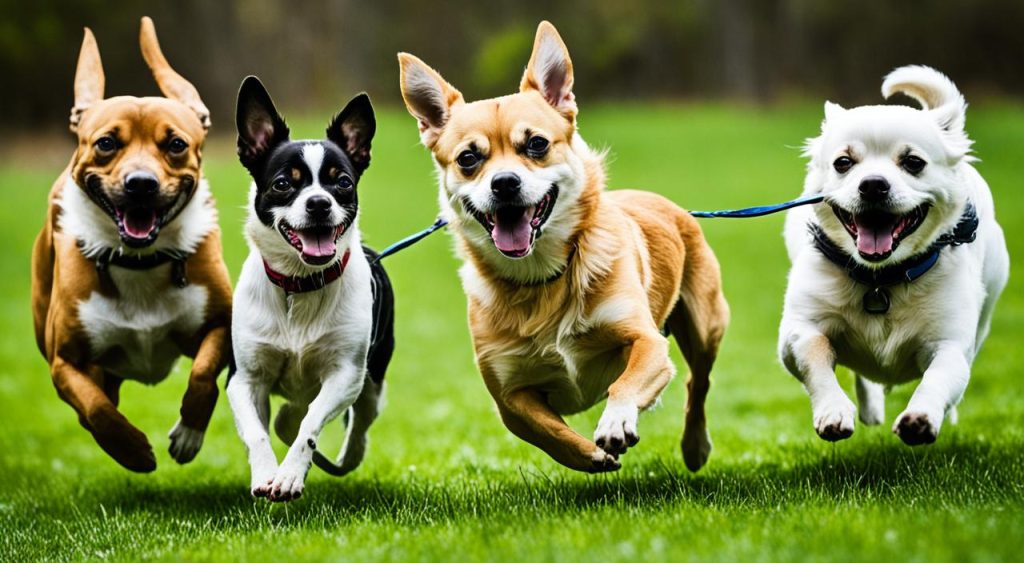Chihuahuas, like many other dogs, have the remarkable ability to understand human words. While the exact number of words they can comprehend may vary, studies suggest that Chihuahuas are capable of learning a significant vocabulary.
According to psychologist Stanley Coren, the average dog can learn around 165 words, while the most intelligent can learn up to 250 words. Another study found that dogs, on average, can understand approximately 200 spoken human words, with some highly trained dogs learning up to nearly 350 words. It’s fascinating to note that a dog’s language ability is comparable to that of a typical two-year-old human child.
Key Takeaways:
- Chihuahuas have the capacity to understand human words.
- Studies suggest that the average dog can learn around 165 words, with the most intelligent dogs learning up to 250 words.
- Dogs’ language ability is comparable to that of a two-year-old human child.
- Some highly trained dogs can understand up to nearly 350 words.
- Chihuahuas, like other dogs, have the potential to comprehend a significant vocabulary.
The Name Game
When you bring home a new Chihuahua, one of the first things you do is give them a name. This is the starting point of communication between you and your pet. By consistently repeating their name, your Chihuahua will eventually learn to recognize it. This milestone can give you a great sense of achievement as your Chihuahua turns their head to look at you when you say their name.
More Words
After your Chihuahua has learned their name, it’s time to expand their vocabulary and teach them new commands. This is an essential part of Chihuahua training, as it allows you to effectively communicate with your furry friend and reinforce positive behaviors. By teaching commands to your Chihuahua, you can establish a strong word association that helps them understand what you want them to do.
Start with common commands such as “sit,” “stay,” “down,” “come,” “fetch,” and “heel.” These are everyday human words that can be easily associated with specific actions. Take the time to demonstrate each command and use consistent hand signals or gestures to accompany the words. This helps your Chihuahua understand the intended meaning behind each command.
“Consistency and repetition are key when teaching commands to your Chihuahua. By consistently using the same words and gestures, you’re helping your Chihuahua build a strong word association and reinforcing their understanding of each command.”
Patience is crucial during the training process. Chihuahuas are intelligent dogs, but they may need some time to fully grasp and respond to the commands. Be sure to reward your Chihuahua with praise, treats, or a favorite toy when they successfully follow a command. This positive reinforcement encourages them to continue learning and helps build a stronger bond between you and your Chihuahua.
By using teaching commands and consistent training methods, you can establish a vocabulary of words that your Chihuahua can understand and respond to. This opens up endless possibilities for effective communication, allowing you to better connect with your Chihuahua and ensure their well-being.
Meet A Real Super Dog: “Chaser”
Chaser, the border collie, captivated the world with her extraordinary language abilities. Owned by John W. Pilley, this remarkable canine achieved a vocabulary of over 1000 words through a dedicated training approach.
“Chaser is one of a kind. She has a vocabulary that is estimated to be at least three to four times larger than any other language-trained dog,” said Pilley, author of the book “Chaser.”
Chaser’s groundbreaking accomplishment was documented in the Behavioural Processes Journal, shedding light on the incredible potential dogs possess for word recognition. Pilley’s gradual introduction of two new toy names each day for three years demonstrated that with the right training and consistent efforts, dogs can comprehend an extensive repertoire of human words.
Chaser’s success serves as a testament to the cognitive capabilities of dogs and challenges previous assumptions about their language comprehension limits. This canine prodigy’s story continues to inspire dog owners and researchers alike, fueling further exploration into the intricacies of our four-legged friends’ linguistic abilities.
The Cognitive Abilities of Dogs
Scientific research has shown that dogs possess cognitive abilities similar to a human child around the age of two. Dogs can respond to approximately 89 words on average, according to a study conducted by researchers at Dalhousie University. This research aimed to develop an inventory of words that dogs consistently respond to.
“Dogs have an astonishing ability to understand and respond to spoken words,” says Dr. Jessica Thompson, lead researcher of the study. “Our findings demonstrate that dogs’ cognitive response to words aligns with their level of comprehension and their ability to associate words with specific actions or objects.”
The study involved testing a diverse group of dog breeds, ranging from Australian Shepherds to Chihuahuas, to assess their language comprehension capabilities. The most responsive breeds included Australian Shepherds, Border Collies, German Shepherds, Bichon Frises, Cavalier King Charles Spaniels, and Chihuahuas.
Dr. Thompson explains, “These breeds consistently demonstrated a high level of understanding and responsiveness to spoken words. However, it’s essential to note that individual dogs within any breed may vary in their language comprehension abilities. Training, socialization, and individual factors play a significant role in a dog’s cognitive response to words.”
Dogs’ Processing of Human Speech
Dogs have a unique way of processing and understanding human speech that differs from our own. According to a study conducted by Eötvös Loránd University, dogs focus more on the overall sound and meaning of words rather than the specific phonetic details. Unlike humans, dogs don’t pay close attention to the intricate sounds and pronunciation of words.
Instead, dogs can differentiate between known words and entirely different nonsense words. For example, if you say “sit” or “fetch,” a dog trained to recognize these words will respond accordingly. However, dogs may struggle to distinguish between known words and nonsense words that sound similar, such as “sit” and “sik.”
This finding suggests that dogs possess a non-detailed phonetic recognition system. While they can understand words based on their general sound and meaning, they may not pay attention to the subtle differences in pronunciation and specific phonetic elements of each word.
Eötvös Loránd University Study
The study conducted by Eötvös Loránd University revealed that dogs focus on the overall sound and meaning of words rather than the specific phonetic details. They can differentiate between known words and entirely different nonsense words but struggle with words that sound similar.
This unique processing style of human speech showcases the distinct way dogs comprehend and interpret language. While they may not process phonetic details in the same way as humans, dogs are still able to understand and respond to the words we use through their own specialized recognition system. This finding highlights the complexity of communication between humans and dogs and further emphasizes the importance of clear and consistent training methods.
Conclusion
While dogs may not possess the same level of language comprehension as humans, they are capable of understanding a significant number of words with proper training and repetition. Dogs’ processing of human speech may differ from ours, but they do listen and respond to the words we use. By using clear commands and consistent training methods, dog owners can enhance their dogs’ understanding of human words. Additionally, some dogs demonstrate exceptional linguistic abilities, suggesting a potential genetic basis for advanced language learning. Ongoing research aims to further uncover the complexities of communication between humans and dogs.





